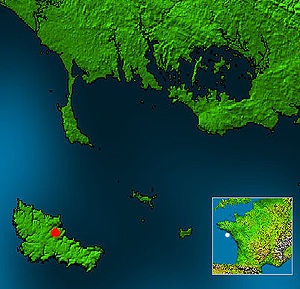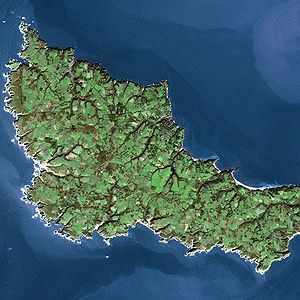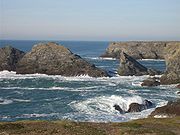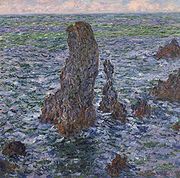
Belle Île
Encyclopedia

Breton language
Breton is a Celtic language spoken in Brittany , France. Breton is a Brythonic language, descended from the Celtic British language brought from Great Britain to Armorica by migrating Britons during the Early Middle Ages. Like the other Brythonic languages, Welsh and Cornish, it is classified as...
; Guedel in Old Breton) is a French
France
The French Republic , The French Republic , The French Republic , (commonly known as France , is a unitary semi-presidential republic in Western Europe with several overseas territories and islands located on other continents and in the Indian, Pacific, and Atlantic oceans. Metropolitan France...
island
Island
An island or isle is any piece of sub-continental land that is surrounded by water. Very small islands such as emergent land features on atolls can be called islets, cays or keys. An island in a river or lake may be called an eyot , or holm...
off the coast of Brittany
Brittany
Brittany is a cultural and administrative region in the north-west of France. Previously a kingdom and then a duchy, Brittany was united to the Kingdom of France in 1532 as a province. Brittany has also been referred to as Less, Lesser or Little Britain...
in the département of Morbihan
Morbihan
Morbihan is a department in Brittany, situated in the northwest of France. It is named after the Morbihan , the enclosed sea that is the principal feature of the coastline.-History:...
, and the largest of Brittany's islands. It is 14 km from the Quiberon
Quiberon
Quiberon is a commune in the Morbihan department in Brittany in north-western France.It is situated on the southern part of the Quiberon peninsula, the northern part being the commune of Saint-Pierre-Quiberon...
peninsula
Peninsula
A peninsula is a piece of land that is bordered by water on three sides but connected to mainland. In many Germanic and Celtic languages and also in Baltic, Slavic and Hungarian, peninsulas are called "half-islands"....
.
Administratively, the island forms a canton: the canton of Belle-Île. It is divided into four communes:
- Bangor
- Le PalaisLe PalaisLe Palais is a commune in the Morbihan department of Brittany in northwestern France.It is one of the four communes on the island Belle Île.-References:* * -External links:* *...
- LocmariaLocmariaLocmaria is a commune in the Morbihan department in Brittany in north-western France. Locmaria is one of the four communes of Belle Île.-References:* * -External links:* * *...
- SauzonSauzonSauzon is a commune in the Morbihan department of the region of Brittany in north-western France.-References:* * -External links:* * * *...
Geography

Altitude
Altitude or height is defined based on the context in which it is used . As a general definition, altitude is a distance measurement, usually in the vertical or "up" direction, between a reference datum and a point or object. The reference datum also often varies according to the context...
of 40 m. The area is about 84 km2. The coasts are a mixture between dangerously sharp cliff edges on the southwest side, the Côte Sauvage (Wild coast), and placid beaches, the largest being les Grands Sables (The great sands) and navigable harbours on the northeast side. The island's climate is oceanic, having less rain and milder winters than on the mainland.
The two main ports are Le Palais (accessible by ferry from Quiberon) and Sauzon (accessible by ferry from Quiberon and Lorient
Lorient
Lorient, or L'Orient, is a commune and a seaport in the Morbihan department in Brittany in north-western France.-History:At the beginning of the 17th century, merchants who were trading with India had established warehouses in Port-Louis...
).
There used to be forests on the island, but these have long disappeared due to increasing agricultural
Agriculture
Agriculture is the cultivation of animals, plants, fungi and other life forms for food, fiber, and other products used to sustain life. Agriculture was the key implement in the rise of sedentary human civilization, whereby farming of domesticated species created food surpluses that nurtured the...
use of the land.
History




Houat
Houat is a French island off the south coast of Brittany in the department of Morbihan. It is located, along with two other major islands, in the entrance to the Baie de Quiberon. Its "twin sister" island is Hoëdic....
and Hœdic
Hoëdic
Hoëdic is an island off the south coast of Brittany in north-western France. Its bigger "twin sister" island is Houat.Administratively, Hoëdic is a commune in the Morbihan department.-References:* * -External links:* *...
. Archaeological finds from the Bronze Age
Bronze Age
The Bronze Age is a period characterized by the use of copper and its alloy bronze as the chief hard materials in the manufacture of some implements and weapons. Chronologically, it stands between the Stone Age and Iron Age...
suggest that the island enjoyed a large increase in population in this time, probably due to improvements in seafaring.
The Roman
Ancient Rome
Ancient Rome was a thriving civilization that grew on the Italian Peninsula as early as the 8th century BC. Located along the Mediterranean Sea and centered on the city of Rome, it expanded to one of the largest empires in the ancient world....
name of the island seems to have been Vindilis, which in the Middle Ages
Middle Ages
The Middle Ages is a periodization of European history from the 5th century to the 15th century. The Middle Ages follows the fall of the Western Roman Empire in 476 and precedes the Early Modern Era. It is the middle period of a three-period division of Western history: Classic, Medieval and Modern...
became corrupted to Guedel. During the ninth century Belle-Île belonged to the county of Cornouaille
Cornouaille
Cornouaille is a historic region in Brittany, in northwest France. The name is identical to the French name for the Duchy of Cornwall, since the area was settled by migrant princes from Cornwall...
.
In 1572 the monks of the abbey of Ste Croix at Quimperlé
Quimperlé
Quimperlé is a commune in the Finistère department of Brittany in northwestern France.-Geography:Quimperlé is in the southeast of Finistère, 20 km to the sest of Lorient and 44 km to the east of Quimper...
ceded the island to the Retz
Jean François Paul de Gondi, cardinal de Retz
Jean François Paul de Gondi, cardinal de Retz was a French churchman, writer of memoirs, and agitator in the Fronde....
family, in whose favour it was raised to a marquisate
Marquess
A marquess or marquis is a nobleman of hereditary rank in various European peerages and in those of some of their former colonies. The term is also used to translate equivalent oriental styles, as in imperial China, Japan, and Vietnam...
in the following year. It subsequently came into the hands of the family of Fouquet. The island's fortifications were erected by Vauban
Vauban
Sébastien Le Prestre, Seigneur de Vauban and later Marquis de Vauban , commonly referred to as Vauban, was a Marshal of France and the foremost military engineer of his age, famed for his skill in both designing fortifications and breaking through them...
on behalf of Nicolas Fouquet
Nicolas Fouquet
Nicolas Fouquet, marquis de Belle-Île, vicomte de Melun et Vaux was the Superintendent of Finances in France from 1653 until 1661 under King Louis XIV...
, prior to Fouquet incurring the displeasure of Louis XIV
Louis XIV of France
Louis XIV , known as Louis the Great or the Sun King , was a Bourbon monarch who ruled as King of France and Navarre. His reign, from 1643 to his death in 1715, began at the age of four and lasted seventy-two years, three months, and eighteen days...
; the land was ceded to the crown in 1718.
Seven Years War
The island was held by British troops from 1761, following its capture by an expedition sent out from England, to 1763, when it was returned to France in exchange for MinorcaMinorca
Min Orca or Menorca is one of the Balearic Islands located in the Mediterranean Sea belonging to Spain. It takes its name from being smaller than the nearby island of Majorca....
as part of the Peace of Paris.
Much of the island's current population is descended from repatriated Acadian colonists who returned to France after being expelled from Acadia (Nova Scotia) during the Great Upheaval
Great Upheaval
The Expulsion of the Acadians was the forced removal by the British of the Acadian people from present day Canadian Maritime provinces: Nova Scotia, New Brunswick, and Prince Edward Island...
.
Today, Belle-Île's population is about 4,000, and its economy is largely dependent on tourism and fishing.
Miscellaneous
During the summer the island's population increases dramatically, as many people own a second homeSecond home
Second home may refer to:* Vacation property* Pied-à-terre* Second Home , an album by Marié Digby...
on the island due to its secluded location and beaches.
Lyrique en Mer/Festival de Belle Île is the largest opera festival in western France. Founded in 1998 by American opera singer Richard Cowan
Richard Cowan (bass-baritone)
Richard Cowan is an American operatic bass-baritone. In 1985 he won the Metropolitan Opera National Council Auditions...
, the Festival produces two staged operas every summer, conducted by Music Director Philip Walsh and directed by Mr. Cowan, the Artistic Director. Additionally, there are sacred concerts in all four of the island's historic churches, as well as many smaller concerts and Master Classes. Lyrique en Mer has wide support from the French business community as well as from the Conseil Général, the Conseil Régional, and the Paris Senate.
The island is the setting for a portion of The Man in the Iron Mask, an adventure novel by 19th century French writer Alexandre Dumas, père
Alexandre Dumas, père
Alexandre Dumas, , born Dumas Davy de la Pailleterie was a French writer, best known for his historical novels of high adventure which have made him one of the most widely read French authors in the world...
. It is where Porthos, one of the characters of Dumas' The Three Musketeers
The Three Musketeers
The Three Musketeers is a novel by Alexandre Dumas, first serialized in March–July 1844. Set in the 17th century, it recounts the adventures of a young man named d'Artagnan after he leaves home to travel to Paris, to join the Musketeers of the Guard...
, dies, close to Locmaria.
During the 1870s and 1880s, French Impressionist
Impressionism
Impressionism was a 19th-century art movement that originated with a group of Paris-based artists whose independent exhibitions brought them to prominence during the 1870s and 1880s...
painter Claude Monet
Claude Monet
Claude Monet was a founder of French impressionist painting, and the most consistent and prolific practitioner of the movement's philosophy of expressing one's perceptions before nature, especially as applied to plein-air landscape painting. . Retrieved 6 January 2007...
painted the rock formations at Belle-Île. Monet’s series of paintings of the rocks at Belle-Île astounded the Paris art world when he first exhibited them in 1887. Most notable are the "Storm, Coast at Belle-Ile" and "Cliffs at Belle-Ile" both rendered in 1886. The first time Auguste Rodin
Auguste Rodin
François-Auguste-René Rodin , known as Auguste Rodin , was a French sculptor. Although Rodin is generally considered the progenitor of modern sculpture, he did not set out to rebel against the past...
saw the ocean off the Brittany coast he exclaimed, “It’s a Monet."

